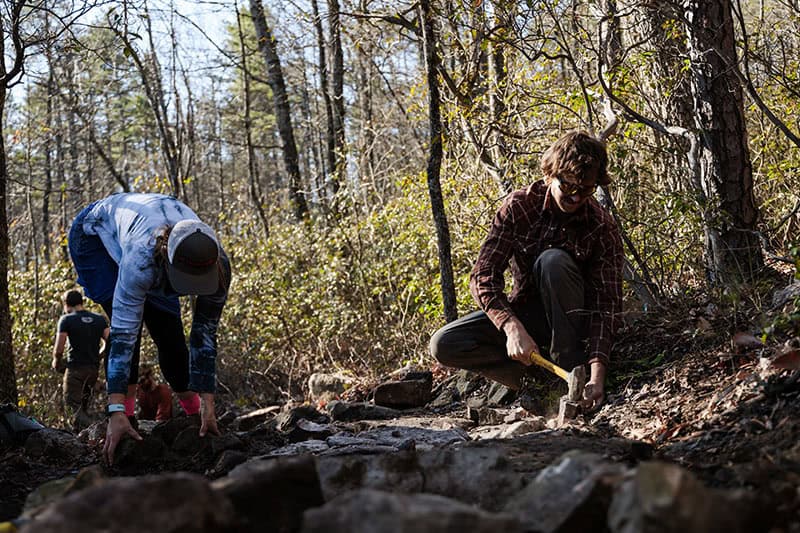Trail Adoption Expectations
What do I need to do? How ‘maintained’ should my trail look, feel, taste?
This is an idea of the minimum level of clearing needed. What we expect once you have agreed to adopt a trail:
Three Brushings/ Sweeps a year: Provided is a general time frame. Some trails have different growth patterns and require different tools. We will try to give better specifics for each trail. This is a learning process so please communicate what you learn about the needs of each trail to help us plan better expectations for the future.
- March: Tools: Chainsaw, Handsaw, Machete, Leaf Rake, Garden Rake. Early Spring for a post-winter sweep of the trails. This will involve mostly chainsaw and clearing of branches. May involve drainage clearing.
- June-July: Early Summer: Tools: Weed Eater (Brusher), Chainsaw, Handsaw Leaf Rake, Machete. This may very well involve a brusher to clear early season growth. A Machete for management of larger diameter material.
- September: Tools: Weed Eater (Brusher), Chainsaw, Handsaw, Leaf Rake, Machete, Garden Rake. This will involve a brusher to clear early season growth. A Machete for management of larger diameter material. Drainage Clearing.
- On-call chainsaw maintenance: We will have a system to announce when new obstructions come down on the trail. It is our hope that as the adopter you will motivate to remove any fallen trees or brush. Again, anyone who is trained (specific training required for chainsaw use in the National Forest) and willing is allowed to step up and remove the obstruction. Please announce any intentions and when work is complete.
Please refrain from the following:
- Altering the course of the trail.
- Building features on the trail.
- Creating new trail.
Trail Maintenance Definitions: (Please read the bottom list of things you may not do without special consideration.)
- Brushing: Using a weedeater with string or a brushing blade. Cut back new growth that encroaches or will soon encroach into the visual and physical path of the trail user. This may mean cutting 1-3ft back from trail edge where needed.
- Chainsawing: Cutting out fallen trees.
- Drainage clearing: Trails are often out-sloped in order to allow water to drain. Over time, organic and other material will collect in the low spots and create a dam that holds water. These drainages need to be raked or dug out so water can flow off the trail.
- Rock clearing: With time rocks will come to the surface and present a loose surface as they roll under your wheels. Loose rocks that are not planted in the ground may be removed from the trail.
- Leaf Raking: Used to make sure cuttings from brusher or machete are swept off the trail. This is not necessarily about raking all leaves off the trail. This is about cleaning up after our work.
Safety and Training
Safety: Each person in a work crew will be provided and be expected to use personal protection devices appropriate to the task they are performing.
- Motorized equipment:
- Hearing and eye protection at all times.
- Chaps for chainsaw and brusher.
- Wear long pants and closed toed shoes at all times.
- Long fingered gloves
- Hand tools are sharp. Be aware of your surroundings and fellow crew when swinging tools.
- Be aware of hazards in the forest.
- Animals: Poisonous snakes, bears, and ticks are the most common hazards.
- Poison Ivy is prevalent in the forest. Learn to identify it.
- Bees, wasps, and ground hornets are common. Warn people in the work party and be sure they carry any medications they need for managing allergic reactions.
First Aid:
- There should always be someone First Aid Certified at a workday.
- A first aid kit will be available and should always be present during trial work.
Training: Training will be available on scheduled dates as well as on request.
- Before operating any motorized equipment you will need to be trained by someone approved to operate them.
- Chainsaws: To operate a chainsaw in the National Forest you must be certified through a chainsaw class.
- Hand tool use and maintenance: Learn good techniques for handling tools such as rakes and machetes. Learn how to sharpen them in order to keep them functioning efficiently and to always leave them sharp and ready for the next crew.
Crew Suggestions:
- Three people working efficiently can clear a lot of trail. Two on point with power tools and one bringing up the rear with hand tools who can clear cuttings as well as cut things not optimal for the brusher or chainsaw.
- More is helpful but remember that you only have so many tools. Make sure everyone has something to do. If a person comes to trail work and doesn’t feel useful they may not feel inspired to come back.
